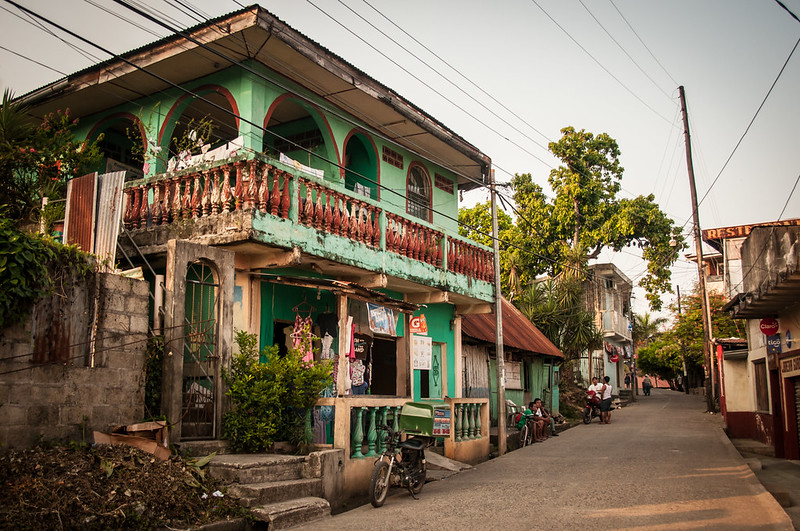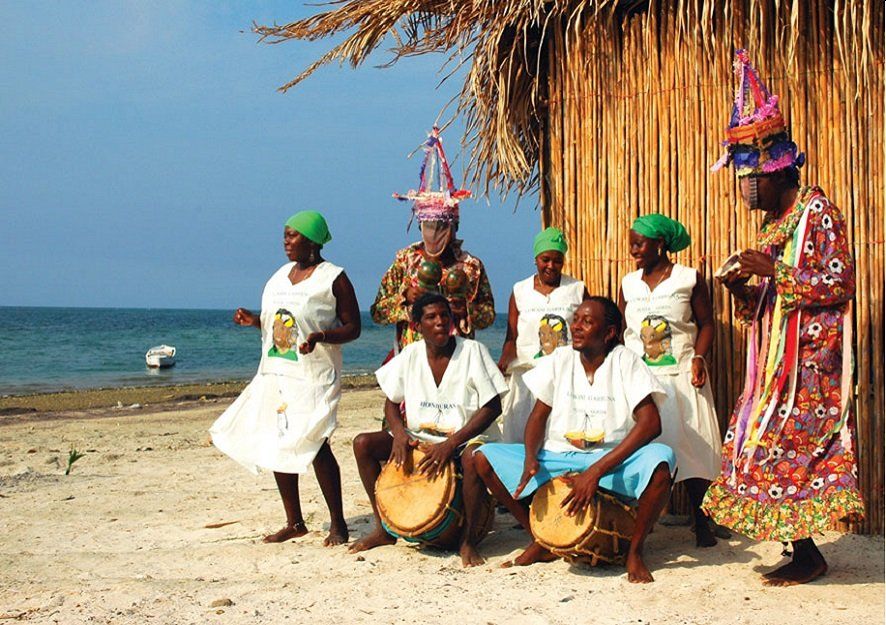A Journey to the Soul of Livingston
Located at the mouth of the Río Dulce, Livingston is a unique destination in Guatemala, renowned not only for its Caribbean landscapes but also for being home to the Garífuna community. This culture, rich in history and traditions, combines African, Amerindian, and Caribbean roots, creating a distinctive identity that captivates travelers. In Livingston, every corner is imbued with this legacy, from the vibrant punta music to the exotic flavors of its cuisine. Immersing yourself in this cultural experience means discovering an essential part of Guatemala’s heritage that differs from any other place in the country.
In this article, we will explore the origins, music, gastronomy, and traditions of the Garífuna culture, revealing why Livingston is an unmissable destination for those seeking an authentic journey.

Origins and Heritage of the Garífuna Culture
The history of the Garífunas dates back to the 17th century, when African slaves were shipwrecked near the island of Saint Vincent and were welcomed by the Indigenous Carib people. This encounter gave rise to a new mixed community which, centuries later, would be known as the Garífunas. In 1797, due to colonial conflicts, this community was exiled to Roatán Island in Honduras and from there dispersed throughout the region, reaching the coasts of Guatemala, Belize, and Nicaragua.
In Livingston, the Garífunas have kept their traditions alive for generations. Their languages—Garífuna and Spanish—are proof of their cultural diversity. Despite the challenges posed by modernity, the community has managed to preserve its customs, standing as a testament to cultural resilience.
Walking through Livingston feels like entering a place where the past and present coexist. The locals are always willing to share stories of their ancestors, making each conversation a window into the soul of their culture.
Punta Music: The Rhythm that Unites the Community
Garífuna music, especially punta, is one of the most emblematic elements of this culture. This musical style combines African drums, maracas, and singing to create a lively rhythm that invites everyone to dance. In Livingston, it’s common to hear punta music echoing around every corner—whether at community celebrations, festivals, or simply family gatherings.
Beyond its festive character, Garífuna music has profound cultural significance. The lyrics often tell stories of daily life, convey teachings, or pay tribute to ancestors. Each performance is an expression of identity and unity, a reminder of their African roots and their connection with nature.
If you visit Livingston, don’t miss the chance to experience a live punta music and dance performance. The quick, coordinated movements of the dancers, accompanied by powerful drumbeats, will transport you to a realm of joy and celebration.
Garífuna Gastronomy: Caribbean Flavors on a Plate
Garífuna cuisine is a delightful fusion of Caribbean, African, and Indigenous flavors. In Livingston, traditional dishes reflect the proximity to the sea and the richness of local ingredients. One of the most notable specialties is tapado, a seafood stew prepared with coconut milk, plantains, and spices, offering a unique explosion of flavors.
Other popular dishes include coconut rice, hudut (mashed plantains served with fish in sauce), and cassava bread rolls. Every bite tells a story, as these recipes have been passed down from generation to generation, preserving ancestral techniques and culinary secrets.
Dining in Livingston is more than just satisfying your hunger; it’s a cultural experience that connects visitors to Garífuna traditions. Many local restaurants are run by families who cook using artisanal methods, ensuring each dish is an authentic representation of their heritage.
Traditions and Festivities: A Living Legacy
Garífuna traditions are an essential part of life in Livingston. Religious festivities, such as the celebration of San Isidro Labrador, combine Catholic elements with Garífuna rituals, resulting in unique ceremonies brimming with symbolism. These occasions bring the community together to celebrate and keep their cultural legacy alive.
Another important tradition is the dugú, a spiritual ritual intended to honor the ancestors. This event features music, dance, and offerings, representing the connection between the living and the spirits of their forebears. Although it’s not open to the public, learning about its significance helps one appreciate the deep spirituality of this culture.
In addition to religious festivities, the Garífunas celebrate their National Day on November 19, commemorating their arrival in Central America. In Livingston, this day is marked by parades, music, and food, giving visitors the chance to be part of one of the region’s most vibrant celebrations.
Livingston is far more than a tourist destination; it is a place where history, culture, and nature intertwine to offer a unique experience. The richness of the Garífuna culture—through its music, cuisine, traditions, and spirituality—makes this corner of Guatemala a true cultural treasure.
Preserving Garífuna Culture in a Globalized World
In an increasingly interconnected world, the Garífuna culture faces challenges linked to globalization and migration. Nonetheless, the Livingston community has demonstrated a remarkable ability to maintain its cultural identity. Preserving their language, traditions, and customs is not only a priority for the Garífunas but also an inspiration to other Indigenous and Afro-descendant communities.
One of the pillars of Garífuna cultural preservation is education. In Livingston, various local organizations and community leaders strive to teach younger generations the Garífuna language and traditional practices. They also promote music and dance workshops, which not only pass down knowledge but also strengthen cultural pride and identity among the youth.
Gastronomy also plays a crucial role in this preservation. Traditional recipes, passed down from one generation to the next, are not just a way to keep history alive; they are also a source of economic support for many families. Through small local businesses, Garífuna women in particular have found a way to share their culture while earning an income.
How Visitors Can Contribute
Cultural tourism can be a powerful tool for preserving Garífuna heritage, provided it is carried out in a respectful and sustainable manner. When visiting Livingston, it’s important to support local initiatives such as buying handicrafts, attending cultural shows, or dining in family-run Garífuna restaurants. This type of tourism not only provides direct income to the community but also promotes cultural exchange.
Participating in cultural activities, like Garífuna cooking classes or dance workshops, can be an enriching experience for both visitors and hosts. Moreover, learning about Garífuna history and traditions helps build awareness of the need to preserve this unique legacy.
Visitors can also contribute simply by showing respect for local culture and customs. Listening to local stories, taking part in celebrations, and valuing their way of life are ways to demonstrate support and appreciation for their heritage.
Nature and Culture: A Perfect Combination
Beyond its cultural richness, Livingston boasts incredible natural diversity that complements the visitor experience. White-sand beaches, crystal-clear waters, and the lush vegetation along the Río Dulce make this destination a paradise for nature lovers.
Among the most popular activities are boat tours on the Río Dulce, which offer stunning views of canyons, mangroves, and abundant biodiversity. Many of these tours include stops in Garífuna communities, allowing visitors to learn more about their way of life.
Another highlight is Playa Blanca, a perfect spot for relaxing and enjoying the Caribbean scenery. While Livingston’s natural beauty is spectacular, no experience here is complete without immersing yourself in the Garífuna culture that surrounds it.

The Influence of Garífuna Culture in Guatemala
Although the Garífunas represent a minority in Guatemala, their cultural impact is significant. Their music, dance, and cuisine have crossed the borders of Livingston, gaining recognition both nationally and internationally. In 2001, UNESCO declared the Garífuna language, dance, and music a Masterpiece of the Oral and Intangible Heritage of Humanity, highlighting the importance of this culture on the global stage.
This recognition has generated increased interest in Garífuna culture, attracting researchers, artists, and tourists from around the world. However, it has also underscored the need to protect this legacy from the threats of modernity and the loss of identity.
Final Reflection
Visiting Livingston is not just a trip to the Guatemalan Caribbean—it’s an opportunity to immerse yourself in one of the region’s richest and most fascinating cultures. From the infectious beat of punta music to the unforgettable taste of tapado, every experience in Livingston is a testament to the resilience and beauty of the Garífuna community.
Preserving this cultural heritage is not solely the responsibility of the Garífunas but also depends on the willingness of visitors and the wider world to value and protect their legacy. When traveling to Livingston, remember that every interaction, every purchase, and every word of support is a contribution to keeping this unique culture alive. Usefull information to visit Tikal in Guatemala in your next trip.
Discovering Garífuna culture in Livingston is more than a simple journey; it’s a transformative experience that connects you with the history, traditions, and very essence of a community proud of its identity.